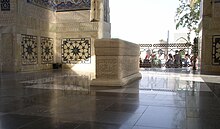Muhammad al-Bukhari
Muhammad Ibn Ismail Ibn Ibrahim Ibn al-Mughirah Ibn Bardizbah al-Bukhari(arabic: محمد بن إسماعيل بن إبراهيم بن المغيرة بن بردزبه البخاري), popularly known as Bukhari orImam Bukhari, (196-256AH / 810-870AD), was a Sunni Islamic scholar of Uzbekistan.He authored the hadith collection named Sahih Bukhari, a collection which Sunni Muslims regard as the most authentic of all hadith compilations.
Biography
Early life
He was born in 810/194 in the city of Bukhara in Khorasan (now in Uzbekistan). His father, Ismail Ibn Ibrahim, was a known hadith scholar who died while he was young
The historian al-Dhahabi described his early academic life:
He began studying hadith in the year 205 (A.H.). He memorized the works of [‘Abdullah] ibn al-Mubaarak while still a child. He was raised by his mother because his father died when he was an infant. He traveled with his mother and brother in the year 210 after having heard the narrations of his region. He began authoring books and narrating hadith while still an adolescent. He said, “When I turned eighteen years old, I began writing about the Companions and the Followers and their statements. This was during the time of ‘Ubaid Allah ibn Musa (one of his teachers). At that time I also authored a book of history at the grave of the Prophet at night during a full moon.
Travels
At age of sixteen, he, together with his brother and widowed mother made the pilgrimage to Makkah. From there he made a series of travels in order to increase his knowledge of hadith. He went through all the important centres of Islamic learning of his time, talked to scholars and exchanged information on hadith. It is said that he heard from over 1,000 men, and learned over 700,000 traditions.
After sixteen years' absence he returned to Bukhara, and there drew up his al-Jami' as-Sahih, a collection of 7,275 tested traditions, arranged in chapters so as to afford bases for a complete system of jurisprudence without the use of speculative law.
His book is highly regarded among Sunni Muslims, and considered the most authentic collection of hadith (a minority of Sunni scholars consider Sahih Muslim, compiled by Bukhari's student Imam Muslim, more authentic). Most Sunni scholars consider it second only to the Qur'an in terms of authenticity. He also composed other books, including al-Adab al-Mufrad, which is a collection of hadiths on ethics and manners, as well as two books containing biographies of hadith narrators.
Last years
Writings
Below is a summary of the discussion of Bukhari's available works in Fihrist Muṣannafāt al-Bukhāri by Umm 'Abdullāh bint Maḥrūs, Muḥammad ibn Ḥamza and Maḥmūd ibn Muḥammad.
Works describing narrators of hadith
Bukhari wrote three works discussing narrators of hadith with respect to their ability in conveying their material: the "brief compendium of hadith narrators," "the medium compendium" and the "large compendium" (al-Tarikh al-Kabīr, al-Tarīkh al-Ṣaghīr, and al-Tarīkh al-Awsaţ). The large compendium is published and well-identified. The medium compendium was thought to be the brief collection and was published as such. The brief compendium has yet to be found.Another work, al-Kunā, is on patronymics: identifying people who are commonly known as "Father of so-and-so". Then there is a brief work on weak narrators: al-Ḍu'afā al-Ṣaghīr.
Hadith Works
Two of Bukhari's hadith works have reached us: al-Adab al-mufrad ("the book devoted to matters of respect and propriety") and al-Jāmi’ al-Musnad al-Sahīh al-Mukhtaṣar min umūr Rasûl Allāh wa sunnanihi wa ayyāmihi – The abridged collection of sound reports with chains of narration going back all the way to the Prophet regarding matters pertaining to the Prophet, his practices and his times. – also known as Sahih Bukhari
School of thought
Bukhari was claimed by followers of the Shafi'i school of thought within Islamic jurisprudence as being from the Shafi school of thought, though members of both the Hanbali and Zahiri schools both levy this claim as well.
He is recorded as being both anti-Mu'tazili and anti-Rafidhi. In one of his books on creed, he wrote: “I don’t see any difference between praying Salah behind a Jahmi or a Rafidhi and a Christian or a Jew. They (Jahmiyyah/Rāfida) are not to be greeted,, nor are they to be visited, nor are they to be married, nor is their testimony to be accepted, nor are their sacrifices to be eaten abc.”.
References
- S. 'Abdul-Maujood, "The Biography of Imam Bukharee", Maktaba Dar-us-Salam, 2005, p. 13.
- Revival of Real Pure Islam, Distinction between Real-Pure Islam and Persian-Brand of Prevailing Islam (book). Page 1.
- Ibn Rāhwayh, Isḥāq (1990), Balūshī, ʻAbd al-Ghafūr ʻAbd al-Ḥaqq Ḥusayn, ed., Musnad Isḥāq ibn Rāhwayh (1st ed.), Tawzīʻ Maktabat al-Īmān, pp. 150–165
- Encyclopedia of World Biography ... – Google Books. 2006-12-28. Retrieved 2010-02-03.
- A guide to Eastern literatures – Google Books. 2008-05-01. Retrieved 2010-02-03.
- Tathkirah al-Huffath, vol. 2, pg. 104-5, al-Kutub al-‘Ilmiyyah edition
- Fihris Muṣannafāt al-Bukhāri, pp. 9-61, Dār al-'Āṣimah, Riyaḍ: 1410.
- Fihris Musannafāt al-Bukhāri, pp. 28-30.
- Imam al-Bukhari (d. 256/870; Tabaqat al-Shafi'iya, 2.212-14 [6])
- Khalq Af’ālul-’Ibād, p.14
-
Muhammad al-Bukhari mausoleum nearSamarkand, Uzbekistan

No comments:
Post a Comment